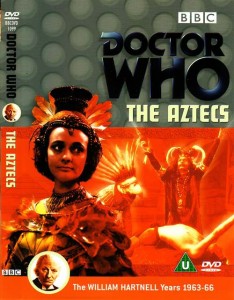 Welcome to the Sixth Instalment of Who Review, my ongoing quest to watch and review all available episodes of SF’s longest running television series, Doctor Who. This week, it’s another jaunt into mankind’s past as I look back on The Aztecs.
Welcome to the Sixth Instalment of Who Review, my ongoing quest to watch and review all available episodes of SF’s longest running television series, Doctor Who. This week, it’s another jaunt into mankind’s past as I look back on The Aztecs.
For a complete listing of all Who Review articles, please click here – Who Review Archive
EPISODES
The Aztecs (4 Episodes)
BROADCAST DATES
23 May – 13 June 1964
THE DOCTOR
William Hartnell
THE COMPANIONS
Susan Foreman
Barbara Wright
Ian Chesterton
THE EPISODES
The TARDIS lands inside a tomb within an Aztec temple in 15th century Mexico. Exploring the temple, they find the remains of Yetaxa, an Aztec High Priest. Barbara nonchalantly takes an arm band off the body and places it around her wrist.
Finding a doorway out of the tomb, the crew finds themselves in an unnamed Aztec city, where Barbara is mistaken by the priests for the female reincarnation of Yetexa and worshipped as a Goddess. Unfortunately, the door to the tomb closes behind them and they cannot find a means of returning to the TARDIS.
Experiencing firsthand the human sacrificial practices of the Aztecs, Barbara seeks to use her newfound position to bring these sacrifices to an end. She seeks the aid of Autloc, the Aztec’s High Priest of Knowledge, who supports her opinion that these sacrifices are barbaric and unnecessary.
There is a definite sense of cultural superiority in this scenario. Barbara finds the practice of human sacrifice abhorrent and murderous, failing to understand the great honour those who are to be sacrificed experience in being chosen for this cause. She goes so far as to suggest that the Aztecs could be saved from their impending slaughter at the hands of the Spanish Conquistadors if they stop these practices. Despite being an expert in the time period and culture of the Aztecs and possessing an understanding of how advanced their society is she remains unwavering in her opinions.
There is an interesting undercurrent to this train of thought, one that is understated in the storyline but still present; the difference between reading about events in history books and experiencing them firsthand. When Barbara first arrives, she talks to Ian and Susan about the architecture and culture of the Aztecs in a very detached, teacher-like fashion. She knows her history and can discuss these elements comfortably, but things are different when she experiences the actual sacrifices firsthand.
Far more interesting, though, is the philosophical argument presented by Barbara and the counterarguments of the Doctor. Barbara seeks an end to human sacrifice and the “barbaric” practices of the Aztecs. The Doctor warns her against this course of action, arguing correctly that he and his companions cannot and should not interfere with the past. “You can’t rewrite history! Not one line!” he tells her, but his argument falls on deaf ears.
The villain of the piece is Tlotoxl, the High Priest of Sacrifice, who sees Barbara as a false God and usurper and seeks to preserve the Aztec way of life and his own power base. He sets into motion a series of schemes to destroy Barbara and the rest of the TARDIS crew. He has Ian drafted into military service and a power struggle with the mighty warrior Ixta for command of the Aztec forces, a rivalry that Tlotoxl flames and manipulates. He has the priest Tonila create a poison and through deception tries to have Barbara drink it. He has Barbara isolated from the rest of the TARDIS crew by questioning her divinity, then has Susan arrested and sent to a seminary for violating Aztec law when she tries to visit Barbara.
Meanwhile, the Doctor continues to seek a way back into the tomb and the TARDIS. He becomes enamoured with Cameca, an Aztec woman he meets in a garden, who quickly falls in love with him. They even share a cocoa drink together, which the doctor fails to realise signifies their engagement. Cameca helps the Doctor find a secret passageway into the temple, and he sends Ian in to open the tomb. Cameca’s story is a brief but poignant one. She is in love with the Doctor, but helps him find a means of escape even though she knows he will leave her once he regains access to the TARDIS.
Susan also becomes embroiled in a romance of sorts. In the seminary, she meets The Perfect Victim, the next human sacrifice. For three days leading up to his death, the Perfect Victim may have anything he chooses. Unfortunately, he chooses to make Susan his bride. She refuses, stating that she should be allowed to choose who she marries. This violates Aztec law, and Tlotoxl uses this to his advantage. Susan must be punished, and he hopes that Barbara’s reluctance to order the harsh punishment will reveal her as a false God.
In the end, Tlotoxl’s schemes are to no avail. The Doctor and his companions manage to escape back into the tomb, sealing the door behind them. They depart knowing that the Doctor was correct in admonishing Barbara and her attempts to change history; the Aztec culture remains as it was and the practice of human sacrifice continues. Barbara finds comfort in the fact that she has at least reached one Aztec; Autloc, the high Priest of Knowledge, who exiles himself from the Aztec city and flees into the jungle to meditate on his beliefs and perhaps find a new way of life.
THE DOCTOR
The Doctor shows a softer side to his nature in his relationship with Cameca, expressing genuine affection for her. This is the first sign of affection we’ve seen from him outside of his paternal relationship with Susan. Slowly, the doctor is becoming a more well-rounded and multi-faceted character.
At the same time, his philosophical arguments with Barbara remind us of the more keenly analytical and moralistic nature of the Doctor, as well as his constant frustration in dealing with Barbara and Ian.
THE COMPANIONS
Barbara is the real star of The Aztecs. She dominates the screen time and provides the moral and philosophical background for the storyline. Her knowledge of Aztec culture offers the viewer a window into that society and her efforts to bring an end of human sacrifice create the ethical and philosophical core
Susan is noticeably absent or a minimal presence throughout this story, due to actress Carol Ann Ford being on holidays for part of the shooting. She has one key moment, when she stands up for her right to choose whom she will marry.
Little is added to Ian’s character during The Aztecs. He continues to be a stoic man of action. Hopefully future episodes will add more to his character as he is beginning to be overshadowed by Barbara.
THE VILLAINS
Tlotoxl is an interesting of somewhat over-the-top villain. Actor John Ringham plays the character with a level of maniacal glee that borders on theatrical overacting. Having said that, Tlotoxl is attempting to preserve the Aztec way of life from outside influence, something that could be considered admirable and worthy were it not for his fiendish, villainous scheming.
FINAL THOUGHTS
Despite some fascinating philosophical arguments on the nature of time travel and the morality of cultural interference and altering the past, The Aztecs is not the most memorable of Doctor Who storylines. It follows the basic story structure of most “white men encounter primitive tribes” storylines and really doesn’t offer anything that cannot be found in other, similar stories.
2 Lukes.
NEXT
We’re back into space with The Sensorites, as we learn a little more about the Doctor’s home planet and see hints of Susan’s psychic abilities.









Generally when I read the Who reviews on this site, my disagreements with you are generally trivial. One of us seems to have missed something with the Aztecs. For me it’s a great story with many interesting characters, moral dilemmas and the beginning of some of the key ethical codes that became intrinsic with every Who story afterward. The story definitely belongs to Barbara…she is magnificent and allows us to discover much of her passions for humanity, equality and justice. Her compassion and intellect is what endeared me to her in the Who novels and is revealed perfectly in this story. I love Tlotoxl (despite his silly name) and believe him to be one of the great early baddies. Autloc is also a highlight – his relationships with Barbara and Tlotoxl are intriguing as he listens to both opposing views and tries to come to terms with the incongruence between his own religion and that of his own feelings of common sense. It’s a great shame the relationship between the Doctor and Cameca was not given further on screen development. It could’ve come at the expense of all of Susan’s scenes. It was hard to believe that a person as well-travelled throughout time and space had never come across arranged marriages before…the Doctor obviously didn’t get to India much! The Aztecs features the theme of not interfering with history for the first time (that I can remember) but more importantly, through Barbara, shows the near impossibility of doing so. One of the things that also stands out during William Hartnell’s Doctor is how he often put his companions lives in danger, whether it be directly (such as in The Daleks) or indirectly (such as supplying poison to Ixta when going into battle with Ian…what was it ok Doc if someone else died????) As for Ian, I’ll speak more about him in my remarks on The Chase but Ian and Barbara have always been two of my favourite Dr Who companions. The reason may well be because I never saw a Hartnell Dr Who episode until I’d read the novels a hundred times each. The novels obviously flesh out their characters more giving their feelings about what they’re seeing, their reactions and most importantly shows their growing relationship and their reliance on each other for support both emotionally and physically. Sadly this (as well as Ian’s character) is best brought out in The Crusades which no longer exists to my knowledge. Whether the two actors here were given scripts that allowed them the time and flexibility to expand Ian and Barbara’s characters is one for you professional and us amateur critics…but for me The Aztecs proved Jacqueline Hill went a long way in achieving that in this 4 part classic
The Aztecs certainly poses some interesting ethical and philosophical questions, and these are the elements that help elevate this story above mediocrity. Unfortunately, I just didn’t find the story as compelling as you did.
I’m glad that this story exists though, mainly due to the fact that it really gives Barabara the chance to shine. Almost instantly, she becomes one of the more interesting and compelling Who companions and has completely overshadowed Ian.
I think Tlotoxl works as a villain because his motives are both clear and relatable. He wants to preserve his way of life. It’s an admirable and sympathetic goal.
The Crusade is missing 2 of its 4 episodes. It may still see the light of day through animation, much like The Invasion, which had its 2 missing episodes (of 8 in total) restored in this fashion.
Later this year, The Reign of Terror (from season 1) is getting a similar release, with episodes 4 and 5 (of 6) being animated.
PS. I raise your two Lukes with two Hans (boom boom!)
Champagne comedy.